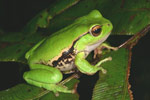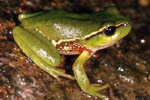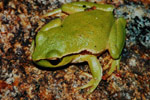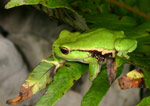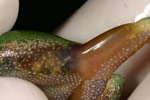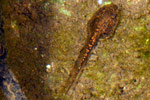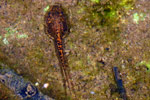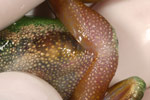Litoria nudidigita
Leaf Green Tree Frog
Also: Leaf Green River Tree Frog

+ 42 kb Leaf Green Tree Frog (Litoria nudidigita)
Measuring 40mm, this small hylid (Victoria's smallest) is an inhabitant of rocky rivers and streams. It is seldom found near still water and is an excellent jumper and swimmer. Previously this frog was included with Litoria phyllochroa but is now considered a unique species distinguishable by distribution and call.
Distribution and habitat

Adults inhabit rocky and mountain streams in rainforest and wet forest. Eggs are spawned in streamside pools and backwaters and the tadpoles actively swim in the flowing water of streams and rivers, clinging to rocks from which they probably feed on surface algae.
There is a detailed distribution map available for: Victoria.
Calling
Males call from streamside vegetation or on rocky riverbanks. The call is in two parts - a long high pitched introductory note or notes followed by a harsh lower pitched note or series of notes - "eeeeeeeek cruk cruk ...... eeeeeeeeek eeeeeeek cruk".
Copyright Murray Littlejohn. Recorded by Murray Littlejohn. Must not be reproduced without permission.
Life cycle
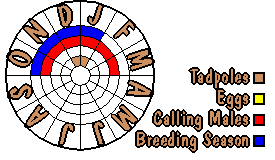
Distinguishing characteristics

+ 33 kb Leaf Green Tree Frog (Litoria nudidigita)
Adult
length: 25-40mm.
The eggs are pigmented in jelly clumps attached to submerged vegetation in streamside backwaters. The tadpoles are dark brown and have transparent fins flecked with dark brown. Adults are bright emerald to dark green or dull brown (even in the same individual at different times) with a broad mottled gold and black band along each side. The back is smooth, the tympanum (ear) is hidden.
Visible features
Presented here is the information stored in the frogs.org.au database which is used to identify frogs based on their appearance. It is intended to be used in a key guide for separating species so some of the information (for example, back colours) may be rather non-specific. The system is currently being developed - if you notice errors in the data, please write to Dave Black at the address at the bottom of the page.
Important note: This information details only the appearance of the frog. If an "or" appears in the description, this may mean either that there is some variation within the species or that the feature might be observed differently by different people. For example, if a frog has very small toe pads, it may be listed as having "Toe pads: present or absent".
Size
Up to less than 30mm
Eyes, hands, and feet
Pupils: horizontal
Toe pads: present
Webbing on feet: half-webbing
Belly
Texture: smooth
Pattern: plain
Colour: single colour
Back
Texture: smooth
Pattern: plain
Colour: single colour
Glands and tubercles
Parotoid gland: absent
Tibial gland: absent
Metatarsal tubercles: absent
Similar species (note: this version was written for Victorian species).
Differentiated from Litoria spenceri by having a smooth back. Can be distinguished from Litoria citropa by the absence of a visible tympanum (ear).
Litoria nudidigita image gallery
Breeding activity
The scientific names of Litoria nudidigita
Alternate
spelling: Litoria nudidigitus
Previously
included within Litoria phyllochroa.
- Hyla phyllochrous nudidigitus (Copland 1962)
- Litoria nudidigita (Copland 1962)

